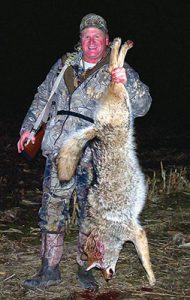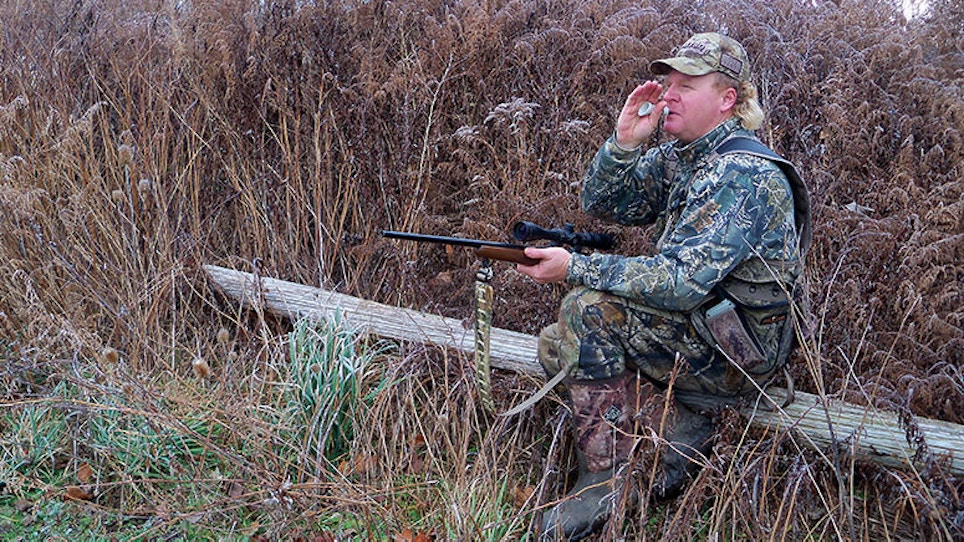It’s interesting to look back at the history of coyote calling. From inception, the rabbit distress call was the staple sound for nearly all hunters. As the sport evolved, hunters realized that Wile E. Coyote could be lured into rifle range with a plethora of other sounds.
By studying the coyotes’ diet, hunters branched out to employ distress sounds of bird, deer and even barnyard animal as a way to dupe the keen-sensed coyote. Hunters then realized coyotes would approach sounds that were not prey distress sounds. These hunters could speak to coyotes in their own language. This calling strategy opened up a flood gate of new calling opportunities for hunters. In fact, the use of various coyote vocalizations has become the rage among the coyote-calling community!
The problem is there is uncertainty on how to successfully use coyote vocalizations. Their language is complex and not easily understood.
Even trained researchers admit to not having a full understanding of the myriad sounds that coyotes make. For a hunter who is trying to use the sounds, whether they be the many variations of howls, barks, Ki-Yi’s, whimpers, growls, etc., the task may seem daunting. Heck, that hunter could feel as if he is back in middle school learning a foreign language all over again!
 Even with a basic understanding of the common sounds that coyotes emit, hunters still have questions regarding the use of coyote vocalizations. Some common questions include:
Even with a basic understanding of the common sounds that coyotes emit, hunters still have questions regarding the use of coyote vocalizations. Some common questions include:
“How many howls should I make to start the set?”
“When should I use male howls vs. female howls?”
“How long should I wait in between howling?”
“Can I make other sounds while howling?”
When using coyote vocalizations, there is a tendency to over-call. Coyotes, especially eastern coyotes, seem to grow weary of repeated howls that drone too long. Additionally, hunters often grow antsy when using coyote vocalizations and end up emitting a wide variety of howls and barks that may actually be counter-productive to bringing real coyotes into the setup.
The key is to present a simple, effective combination of sounds that takes the guess work out of many of the questions that hunters have.
A Foolproof Sequence
I cannot claim ownership of this sequence as it was actually given to me by FOXPRO’s Mike Dillon. Mike mentioned this sequence was working wonders as he spanned the country in his quest to take a coyote in each state. Even “Big Al” Morris mentioned the effectiveness of the sequence on the Furtaker’s TV show.
The combo consists of only three sounds, presented in a specific order, and is foul-proof. There is no need to worry about over or under calling when using this sequence. I should mention the sounds used are from the FOXPRO sound library.
Hunters who do not use a FOXPRO call can still perform the sequence by using similar electronic sounds or duplicating the sounds while using a mouth-blown call.
The First Sound
The first sound to emit is Male Coyote Howls (C34 in FOXPRO Library). The important thing to remember is to manually control the sound so it does not play too long. I use the mute button on the remote to play only two or three howls. I then allow for several minutes of silence. For hunters who call consistently, three minutes of silence seems like a long time, so monitor the time to allow a sufficient break. After the silent break, I allow the male howls to commence. Again, I only emit two or three male howls then wait in silence for another few minutes. Day or night, I continue to scan for motion of an approaching coyote. In my experience, I do not typically see the coyotes approach at this point in the sequence. However, I have to believe I am setting them up for an approach.
The Second Sound
The second sound in the sequence is the Female Yodel Howl (C28 in the FOXPRO library). Again, I do not play this sound continuously. As before, I use the mute button to intermittently play howls — usually only emitting two to three minutes at a time. After several minutes of silence, I repeat with two to three minutes of Female Yodel Howls. As far as volume is concerned, I typically play this howl sound, as well as the first, at maximum volume. Keep in mind I usually hunt in wide open spaces, so the loud volume is warranted. When hunting in tighter cover, I may back down volume. After two series of the Female Yodel Howl, we have made both male and female sounds and real coyotes may respond by howling or approaching for territorial/mating reasons. However, I see most coyotes while the final sound is playing.
The Third Sound
The third sound is Coyote Pup Distress No. 3 (C27 in the FOXPRO Library). This is the “finisher” of the sequence. In contrast to the first two sounds, I play this one nonstop. I also lower the volume when playing this sound, even in open terrains — mid to mid-high volume will suffice. I certainly do not blare the sound on maximum volume. Of course, volume is often dependent upon factors like e-call type, weather conditions and terrain.
Hunters will want to stay alert as the pup distress sound fills the air. The pup distress sound can be played for five to 10 minutes, as this usually enough time for any proximate coyotes to appear.
Conclusion
Why is this sequence so effective? I have to believe that the simple combination of howls draws the attention of curious coyotes then they get pulled in with the culminating pup distress. I do know all hunters, regardless of calling experience, can use this sequence with confidence knowing it has been proven effective all across the country!






